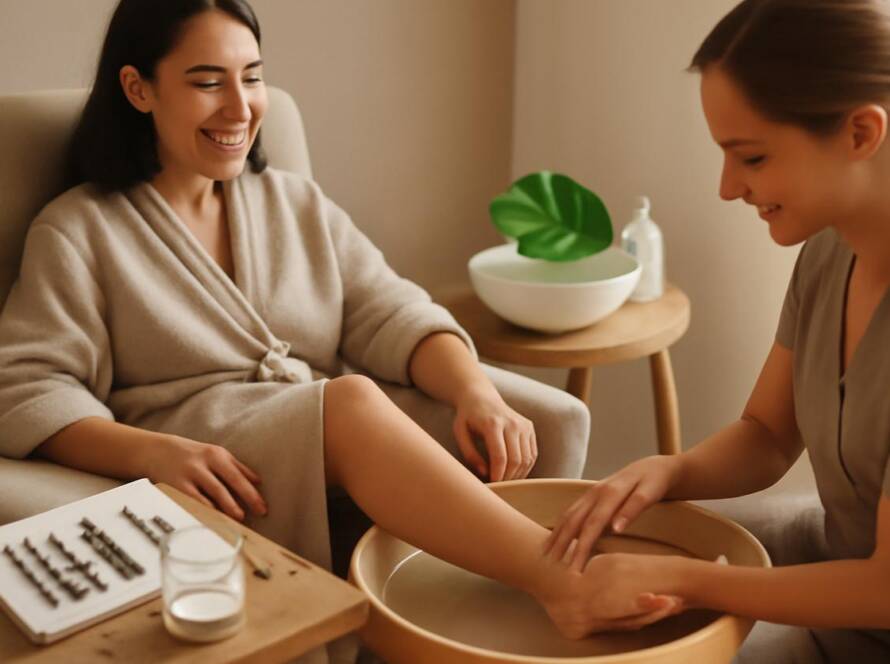Achieve visibly healthier skin in 30 days. This guide offers busy professionals and beginners quick, evidence-based skincare tips and micro-routines for a lasting, radiant glow without the confusing jargon.
Quick Start: 7 Evidence-Based Microsteps (1–5 minutes)
Transform your skin with these simple, effective micro-habits. Each takes just a few minutes but delivers significant long-term benefits. These foundational skincare tips are perfect for anyone starting their journey.
- Cleanse with Purpose (60 seconds): Gently massage a mild cleanser onto your face for a full minute. This ensures you dissolve dirt, oil, and pollutants without stripping your skin.
- Pat, Don’t Rub (10 seconds): After washing, gently pat your skin dry with a clean, soft towel. Aggressive rubbing can cause micro-tears and irritation.
- Apply to Damp Skin (30 seconds): Apply your serums and moisturizers to slightly damp skin. This helps lock in hydration and improves product absorption.
- Sunscreen Every Single Day (60 seconds): The most crucial step. Apply a broad-spectrum sunscreen with at least SPF 30 every morning, even on cloudy days or when indoors.
- Hands Off (0 seconds): Make a conscious effort to avoid touching your face throughout the day. This simple action minimizes the transfer of bacteria and dirt that can lead to breakouts.
- Hydrate from Within (20 seconds): Keep a glass of water on your desk. Proper hydration is a cornerstone of plump, healthy-looking skin.
- Clean Your Phone Screen (30 seconds): Your phone screen harbors bacteria that can transfer to your cheek and jawline. Wipe it down daily with an antibacterial wipe.
How Skin Works: Simple Science Behind Results
Understanding the basics of your skin helps you appreciate why certain skincare tips work. Your skin is a complex organ, but its health primarily relies on a few key functions.
The Skin Barrier
Think of your outermost skin layer, the epidermis, as a brick wall. The skin cells are the bricks, and lipids (fats) are the mortar holding them together. This is your skin barrier. Its job is to keep moisture in and harmful things like pollution and bacteria out. A damaged barrier leads to dryness, redness, and sensitivity.
Cell Turnover & Collagen
Your skin is constantly renewing itself through a process called cell turnover, where new cells replace old ones. This process slows with age. Ingredients like exfoliants and retinoids help speed it up. Deeper in the skin, collagen and elastin provide structure and firmness. Sun damage is the primary cause of collagen breakdown, leading to wrinkles and sagging.
Morning Ritual: Step-by-step with Product-Function Notes
Your morning routine should focus on protection from environmental stressors. Keep it simple and consistent.
- Cleanse: Use a gentle, hydrating cleanser to remove any oil and sweat from the night. Its function is to create a clean canvas without stripping the skin barrier.
- Treat (Antioxidant Serum): Apply a Vitamin C serum or another antioxidant. Its function is to neutralize free radicals from UV rays and pollution, preventing cellular damage.
- Moisturize: Use a moisturizer suited to your skin type (lotion for oily skin, cream for dry skin). Its function is to hydrate and support the skin barrier.
- Protect (Sunscreen): This is non-negotiable. Apply a broad-spectrum SPF 30 or higher. Its function is to shield your skin from UVA/UVB rays, preventing premature aging and skin cancer. This is the most important of all daily skincare tips.
Evening Ritual: Repair-Focused Routine and Timing
Your skin does most of its repairing overnight. Your evening routine should focus on cleansing thoroughly and delivering powerful treatment ingredients.
- Double Cleanse (if applicable): Start with an oil-based cleanser to break down makeup, sunscreen, and sebum. Follow with a water-based cleanser to wash everything away. This ensures your skin is truly clean and ready for treatment.
- Treat (Actives): This is the time for targeted treatments like retinoids (to boost collagen and cell turnover), chemical exfoliants (like AHAs/BHAs), or hydrating serums. Apply your chosen treatment to dry skin to minimize potential irritation.
- Moisturize: Finish with a nourishing moisturizer to lock in your treatment and support your skin barrier as it repairs overnight.
Weekly Targets: Masks, Exfoliation, and Targeted At-Home Treatments
In addition to your daily routine, incorporating weekly treatments can accelerate your results.
Exfoliation
Exfoliating 1-3 times per week removes dead skin cells, brightens the complexion, and improves product absorption. For 2025 and beyond, focus on chemical exfoliants over harsh physical scrubs.
- Alpha-Hydroxy Acids (AHAs): Glycolic and lactic acids are great for targeting surface texture and hyperpigmentation.
- Beta-Hydroxy Acids (BHAs): Salicylic acid is oil-soluble, making it ideal for clearing out pores and managing acne.
Masks and Treatments
Use masks to address specific concerns. A clay mask can help with oiliness, while a hydrating mask with hyaluronic acid can soothe dryness. Listen to your skin and choose what it needs that week.
Ingredient Cheat Sheet: What to Use and What to Avoid
Navigating ingredients can be daunting. Here are some of the best, categorized by sensitivity tiers.
| Ingredient Function | Tier 1 (Robust/Tolerant Skin) | Tier 2 (Sensitive/Reactive Skin) | What to Avoid (All Skin) |
|---|---|---|---|
| Hydrators | Hyaluronic Acid, Glycerin, Ceramides | Hyaluronic Acid, Glycerin, Squalane | Drying Alcohols (SD Alcohol, Denatured Alcohol) |
| Antioxidants | L-Ascorbic Acid (Vitamin C), Ferulic Acid | Niacinamide, Vitamin E, Green Tea Extract | Unnecessary Fragrance/Parfum, Essential Oils |
| Exfoliants | Glycolic Acid (AHA), Salicylic Acid (BHA) | Lactic Acid (AHA), Mandelic Acid (AHA), PHAs | Harsh Physical Scrubs (nutshells, large crystals) |
| Cell Regulators | Retinoids (Tretinoin, Retinal) | Retinol, Bakuchiol (a plant-based alternative) | High concentrations of irritating ingredients |
Patch Testing & Safety: Quick Compliance Checklist
Before introducing any new product, always perform a patch test to avoid a widespread reaction.
- Apply a small amount of the product to a discreet area of skin, like behind your ear or on your inner arm.
- Wait 24-48 hours. Do not wash the area during this time.
- Check for reactions. Look for signs of redness, itching, swelling, or blistering.
- If no reaction occurs, the product is likely safe to use on your face.
Aftercare Basics: Redness, Irritation, and Short Recovery Templates
Sometimes, skin reacts. If you experience redness or irritation, pause your routine and focus on recovery.
Irritation Recovery Template (3-5 Days)
- Morning: Rinse with cool water (no cleanser), apply a simple, fragrance-free moisturizer with ceramides, and finish with SPF.
- Evening: Wash with a gentle, creamy cleanser, and apply the same simple moisturizer.
- Action: Stop all active ingredients—this includes retinoids, exfoliants, and Vitamin C—until your skin barrier has fully recovered.
When to Consider In-Clinic Options
Consistent at-home skincare is powerful, but some concerns are best addressed with a professional. If you struggle with persistent conditions like severe acne, rosacea, deep wrinkles, or significant scarring, consulting a board-certified dermatologist is recommended. They can provide accurate diagnoses and discuss professional treatments. For more information, the American Academy of Dermatology is an excellent resource.
Sustainable Habits: Low-Waste Swaps and Product Stewardship
Adopt eco-friendly practices in your routine. Small changes can make a big impact.
- Choose Refillable Packaging: Many brands now offer refills for their products, reducing plastic waste.
- Use Reusable Cotton Rounds: Swap disposable cotton pads for washable bamboo or fabric rounds.
- Finish Your Products: Use up a product completely before buying a new one to reduce waste and save money.
- Look for Multi-Use Products: A hydrating cleanser can remove makeup, and a tinted SPF can replace foundation, streamlining your routine and consumption.
30-Day Skin Reset: Week-by-Week Micro-Goals
Follow this structured plan for visible changes in just one month. This framework is one of the most effective skincare tips for building lasting habits.
Week 1: Build the Foundation
Goal: Establish a consistent morning and evening routine.
Actions: Focus only on the core three steps: Cleanse, Moisturize, and SPF (AM). Do this every single day. The goal is consistency, not complexity.
Week 2: Introduce an Antioxidant
Goal: Add protection and brightness to your morning routine.
Actions: Continue with your foundation routine. In the morning, after cleansing, introduce a gentle antioxidant serum like Niacinamide or a low-concentration Vitamin C.
Week 3: Add a Weekly Treatment
Goal: Boost cell turnover and address specific concerns.
Actions: Continue your daily routine. Once this week, introduce a gentle chemical exfoliant (like a lactic acid serum) or a hydrating mask in the evening.
Week 4: Refine and Observe
Goal: Assess progress and listen to your skin.
Actions: Your full routine is now established. Pay attention to how your skin looks and feels. Is it hydrated? Are you seeing any irritation? Adjust as needed and enjoy the results of your consistency.
Accessibility & Inclusivity Notes
Great skin health is for everyone. Effective skincare tips should be adaptable.
- Skin Tone: Individuals with melanin-rich skin may be more prone to hyperpigmentation. Consistent SPF use and ingredients like niacinamide and azelaic acid are particularly beneficial. Seek advice on exfoliation to avoid post-inflammatory hyperpigmentation.
- Texture & Sensory Needs: Skincare is a sensory experience. If you dislike heavy creams, opt for gel or lotion textures. If you are sensitive to smells, always choose fragrance-free products.
- Physical Accessibility: Look for packaging that is easy to open and use, such as pumps instead of jars, if you have dexterity challenges.
Short FAQs
How long does it take to see results from a new skincare routine?
Consistency is key. You may notice hydration benefits within a few days, but for texture and tone improvements from active ingredients, give it at least 4-6 weeks. Full results from ingredients like retinoids can take 3-6 months.
Do I really need a separate eye cream?
Not always. If your regular facial moisturizer is fragrance-free and well-tolerated around your eyes, it’s often sufficient. However, eye creams are specifically formulated for the delicate skin in that area and may contain targeted ingredients for concerns like dark circles or puffiness.
Is a toner a necessary step?
Modern toners are not the harsh, alcohol-based astringents of the past. Today, they are often formulated to provide hydration or gentle exfoliation. While not strictly necessary for everyone, a hydrating toner can be a great way to add moisture to your routine, especially for dry skin types.
References & Further Reading
For evidence-based information and professional advice, consult these authoritative sources:
- American Academy of Dermatology (AAD): A comprehensive resource for skin health information for the public and professionals.
- British Association of Dermatologists (BAD): Provides patient information leaflets on a wide range of skin conditions.
- PubMed: A database of biomedical literature for finding peer-reviewed studies on skincare ingredients and efficacy.
- Cochrane Skin Reviews: Offers systematic reviews of evidence for dermatological treatments.
- NIH — NIAMS: The National Institute of Arthritis and Musculoskeletal and Skin Diseases provides reliable information on skin health.
- Journal of Clinical and Aesthetic Dermatology: A peer-reviewed publication for in-depth research on cosmetic dermatology.



